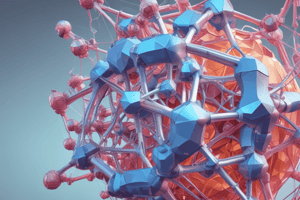Podcast
Questions and Answers
What distinguishes solids from gases and liquids?
What distinguishes solids from gases and liquids?
- High mobility of particles
- Repetitive and ordered pattern of particles (correct)
- Random arrangement of particles
- Absence of atomic size variability
In a simple cubic lattice, how many nearest neighbors does each lattice point have?
In a simple cubic lattice, how many nearest neighbors does each lattice point have?
- 12
- 7
- 8
- 6 (correct)
What determines the type of lattice structure an element or compound adopts?
What determines the type of lattice structure an element or compound adopts?
- Atomic size, shape, and charges (correct)
- Number of protons
- Magnetic properties
- Valence electrons
How many nearest neighbors does a lattice point have in a face-centered cubic lattice (FCC)?
How many nearest neighbors does a lattice point have in a face-centered cubic lattice (FCC)?
What is the distinguishing feature of a hexagonal close-packed (HCP) lattice structure?
What is the distinguishing feature of a hexagonal close-packed (HCP) lattice structure?
Which type of lattice structure has a lattice point with 8 nearest neighbors?
Which type of lattice structure has a lattice point with 8 nearest neighbors?
What determines the overall geometry of a lattice in a crystal structure?
What determines the overall geometry of a lattice in a crystal structure?
Which type of lattice exhibits fourfold rotational symmetry and has two different axes?
Which type of lattice exhibits fourfold rotational symmetry and has two different axes?
What type of bond involves shared electrons between atoms or ions in a crystal lattice?
What type of bond involves shared electrons between atoms or ions in a crystal lattice?
Which representation of a crystal structure uses interconnected spheres to depict atoms or ions?
Which representation of a crystal structure uses interconnected spheres to depict atoms or ions?
Which factor is fundamental to describing the properties of a solid-state material?
Which factor is fundamental to describing the properties of a solid-state material?
What kind of symmetry does a hexagonal lattice exhibit?
What kind of symmetry does a hexagonal lattice exhibit?
Flashcards are hidden until you start studying
Study Notes
Understanding Solid State: Crystal Structure
In the realm of materials science, the term "solid state" refers to a state of matter where particles—atoms, ions, or molecules—are arranged in a repetitive, ordered pattern we call a crystal structure. This organization leads to unique physical and chemical properties that distinguish solids from other states of matter like gases and liquids.
The Building Blocks of Crystal Structure: Atoms and Ions
The constituent elements within a solid state material, be they atoms or ions, are arranged in a repetitive pattern to create a lattice or latticework. These lattice points are the locations where atoms or ions are present in the crystal structure.
The type of lattice structure an element or compound adopts depends on its atomic size, shape, and charges. Common lattice structures include:
- Simple cubic lattice: Each lattice point has 6 nearest neighbors.
- Body-centered cubic lattice (BCC): Each lattice point has 8 nearest neighbors (origin and its four corners plus the center point).
- Face-centered cubic lattice (FCC): Each lattice point has 12 nearest neighbors (origin plus the centers of the six faces).
- Hexagonal close-packed (HCP): A variant of FCC with stacked layers in a hexagonal arrangement.
Ordered Arrangements: Lattice Geometry
The lattice structure in a crystal can be thought of as a repeating pattern of points in space. The repeating unit is called the unit cell, and its dimensions dictate the overall geometry of the lattice. The most common unit cell shapes are:
- Cubic: Simple cubic, body-centered cubic, and face-centered cubic lattices all share this geometry.
- Tetragonal: A lattice with fourfold rotational symmetry and two different axes.
- Hexagonal: A lattice with sixfold rotational symmetry and one axis longer than the other two.
- Orthorhombic: A lattice with three different axes.
Bonding in Crystal Structures
The arrangement of atoms or ions in a crystal lattice influences the type of bonds that form between them, which in turn affects the properties of the material. Common types of bonds in solid-state materials include:
- Covalent bonds: Shared electrons between atoms or ions that make up the lattice.
- Metal-metal bonds: Electrons are delocalized across the lattice, leading to a shared electron density between metal atoms.
- Ionic bonds: Electrons transfer from a metal to a non-metal, resulting in positively and negatively charged ions.
Examining Crystal Structures
To visualize the arrangement of atoms or ions in a solid-state material, chemists use a representation of the crystal structure called the space-filling model. This model is based on the unit cell and the positions of lattice points. A more simplified representation, known as the ball-and-stick model, depicts a lattice as a series of interconnected spheres, where each sphere represents an atom or ion.
Understanding the crystal structure of a material is fundamental to describing its properties, such as its melting and boiling points, hardness, and electrical conductivity. This knowledge allows materials scientists to create or modify materials with specific properties for various applications, from everyday items like glass and metals to advanced technologies like semiconductors and batteries.
In summary, the crystal structure of a solid-state material plays a vital role in defining its properties and influences the way it interacts with its environment. By understanding the various lattice structures and their geometries, we can explore the wide range of materials science applications, from basic research to technological advancements.
Studying That Suits You
Use AI to generate personalized quizzes and flashcards to suit your learning preferences.




